Unit 3 I'm more outgoing than my sister. Section A【人教八上英语教案精彩课堂(教案+素材)】
文档属性
| 名称 | Unit 3 I'm more outgoing than my sister. Section A【人教八上英语教案精彩课堂(教案+素材)】 | 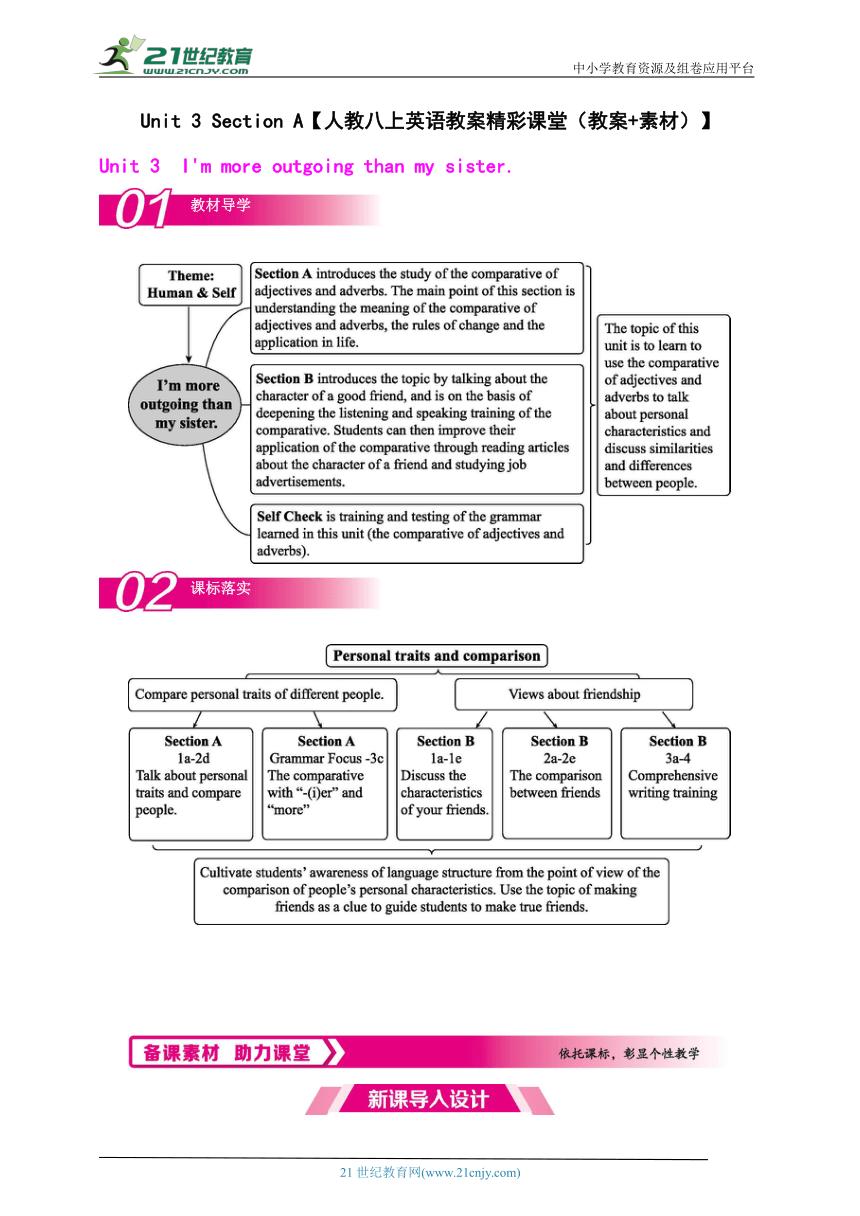 | |
| 格式 | docx | ||
| 文件大小 | 812.8KB | ||
| 资源类型 | 试卷 | ||
| 版本资源 | 人教新目标(Go for it)版 | ||
| 科目 | 英语 | ||
| 更新时间 | 2024-09-02 11:32:18 | ||
图片预览

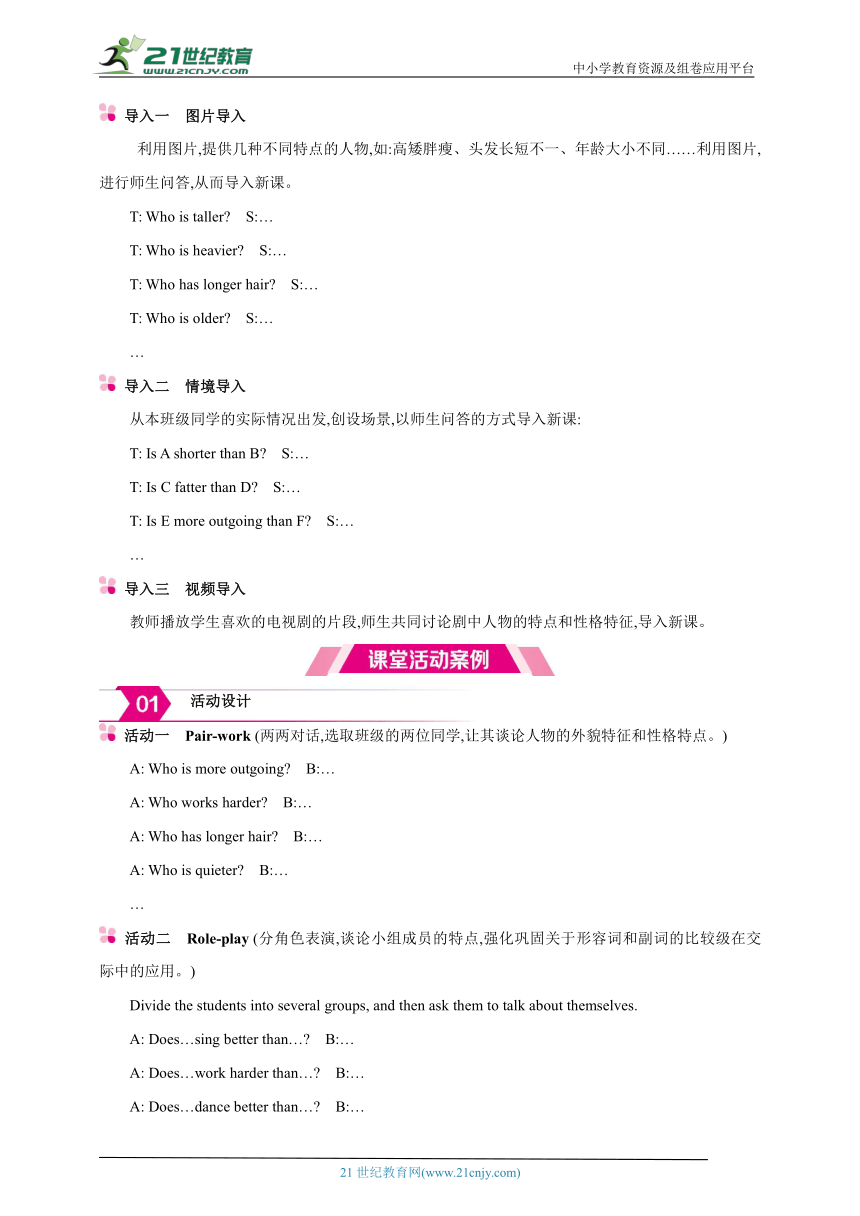
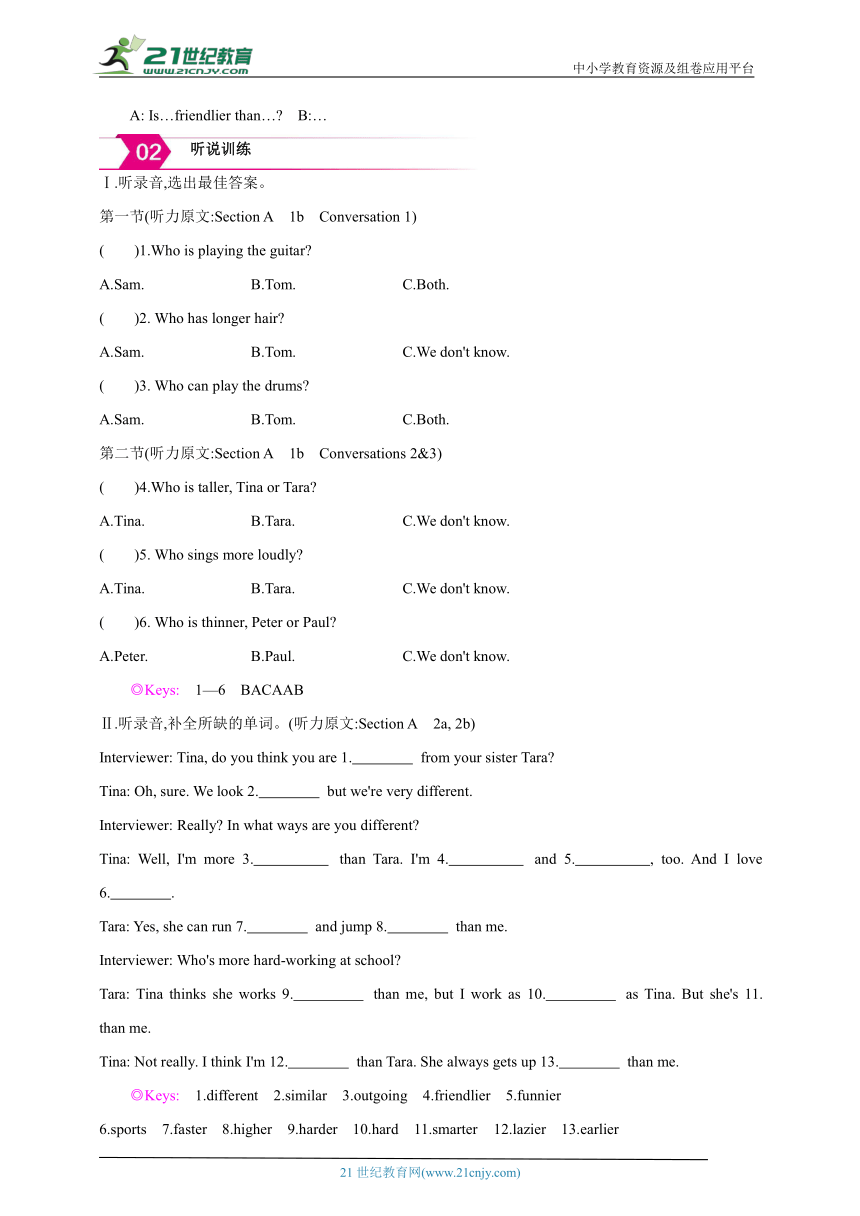
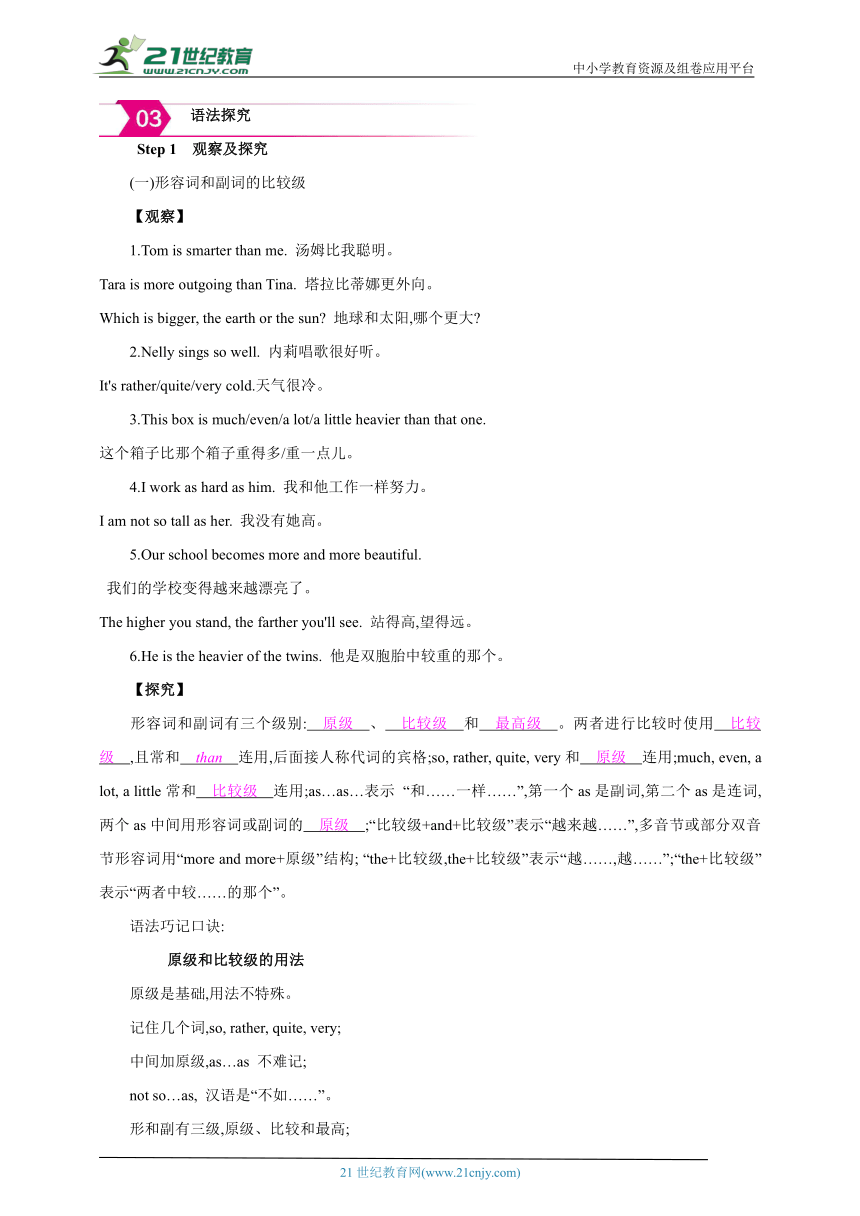
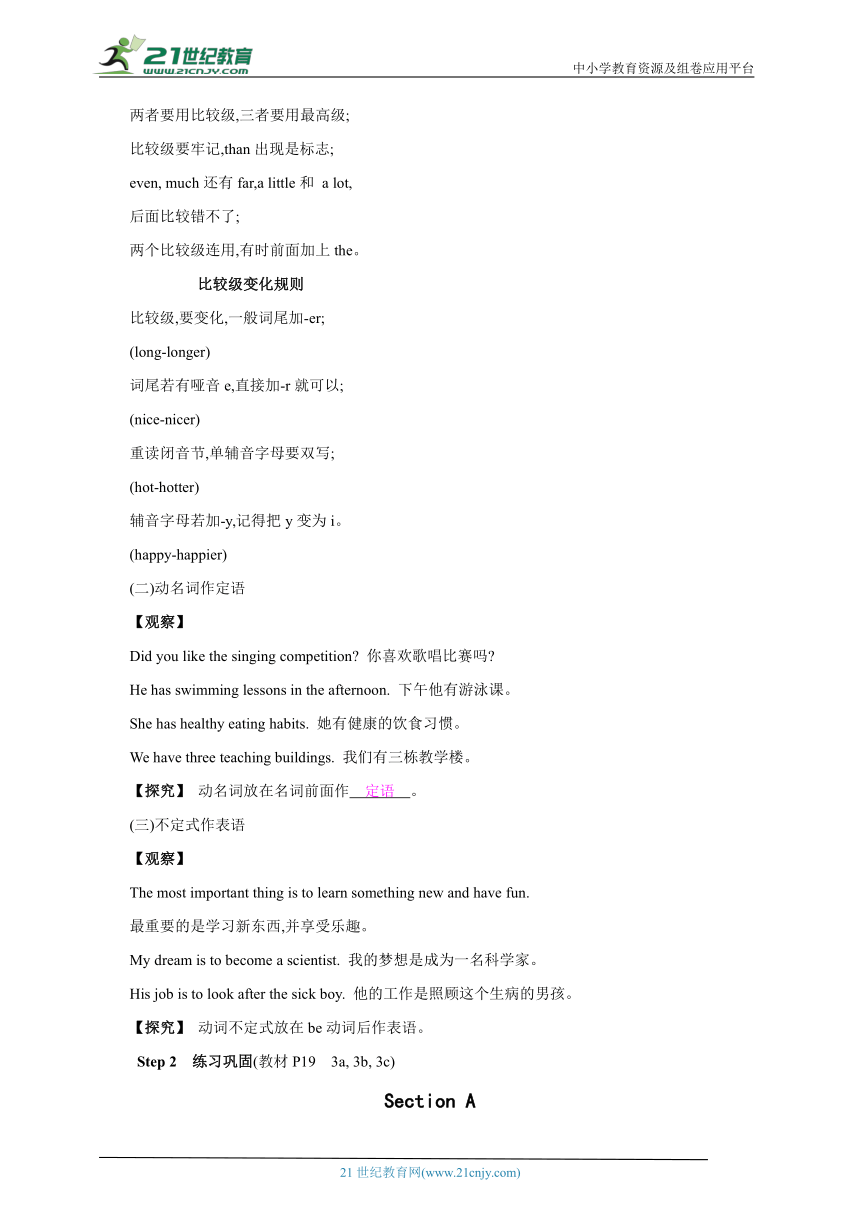
文档简介
中小学教育资源及组卷应用平台
Unit 3 Section A【人教八上英语教案精彩课堂(教案+素材)】
Unit 3 I'm more outgoing than my sister.
教材导学
课标落实
导入一 图片导入
利用图片,提供几种不同特点的人物,如:高矮胖瘦、头发长短不一、年龄大小不同……利用图片,进行师生问答,从而导入新课。
T: Who is taller S:…
T: Who is heavier S:…
T: Who has longer hair S:…
T: Who is older S:…
…
导入二 情境导入
从本班级同学的实际情况出发,创设场景,以师生问答的方式导入新课:
T: Is A shorter than B S:…
T: Is C fatter than D S:…
T: Is E more outgoing than F S:…
…
导入三 视频导入
教师播放学生喜欢的电视剧的片段,师生共同讨论剧中人物的特点和性格特征,导入新课。
活动设计
活动一 Pair-work (两两对话,选取班级的两位同学,让其谈论人物的外貌特征和性格特点。)
A: Who is more outgoing B:…
A: Who works harder B:…
A: Who has longer hair B:…
A: Who is quieter B:…
…
活动二 Role-play (分角色表演,谈论小组成员的特点,强化巩固关于形容词和副词的比较级在交际中的应用。)
Divide the students into several groups, and then ask them to talk about themselves.
A: Does…sing better than… B:…
A: Does…work harder than… B:…
A: Does…dance better than… B:…
A: Is…friendlier than… B:…
听说训练
Ⅰ.听录音,选出最佳答案。
第一节(听力原文:Section A 1b Conversation 1)
( )1.Who is playing the guitar
A.Sam. B.Tom. C.Both.
( )2. Who has longer hair
A.Sam. B.Tom. C.We don't know.
( )3. Who can play the drums
A.Sam. B.Tom. C.Both.
第二节(听力原文:Section A 1b Conversations 2&3)
( )4.Who is taller, Tina or Tara
A.Tina. B.Tara. C.We don't know.
( )5. Who sings more loudly
A.Tina. B.Tara. C.We don't know.
( )6. Who is thinner, Peter or Paul
A.Peter. B.Paul. C.We don't know.
◎Keys: 1—6 BACAAB
Ⅱ.听录音,补全所缺的单词。(听力原文:Section A 2a, 2b)
Interviewer: Tina, do you think you are 1. from your sister Tara
Tina: Oh, sure. We look 2. but we're very different.
Interviewer: Really In what ways are you different
Tina: Well, I'm more 3. than Tara. I'm 4. and 5. , too. And I love 6. .
Tara: Yes, she can run 7. and jump 8. than me.
Interviewer: Who's more hard-working at school
Tara: Tina thinks she works 9. than me, but I work as 10. as Tina. But she's 11. than me.
Tina: Not really. I think I'm 12. than Tara. She always gets up 13. than me.
◎Keys: 1.different 2.similar 3.outgoing 4.friendlier 5.funnier
6.sports 7.faster 8.higher 9.harder 10.hard 11.smarter 12.lazier 13.earlier
语法探究
Step 1 观察及探究
(一)形容词和副词的比较级
【观察】
1.Tom is smarter than me. 汤姆比我聪明。
Tara is more outgoing than Tina. 塔拉比蒂娜更外向。
Which is bigger, the earth or the sun 地球和太阳,哪个更大
2.Nelly sings so well. 内莉唱歌很好听。
It's rather/quite/very cold.天气很冷。
3.This box is much/even/a lot/a little heavier than that one.
这个箱子比那个箱子重得多/重一点儿。
4.I work as hard as him. 我和他工作一样努力。
I am not so tall as her. 我没有她高。
5.Our school becomes more and more beautiful.
我们的学校变得越来越漂亮了。
The higher you stand, the farther you'll see. 站得高,望得远。
6.He is the heavier of the twins. 他是双胞胎中较重的那个。
【探究】
形容词和副词有三个级别: 原级 、 比较级 和 最高级 。两者进行比较时使用 比较级 ,且常和 than 连用,后面接人称代词的宾格;so, rather, quite, very和 原级 连用;much, even, a lot, a little常和 比较级 连用;as…as…表示 “和……一样……”,第一个as是副词,第二个as是连词,两个as中间用形容词或副词的 原级 ;“比较级+and+比较级”表示“越来越……”,多音节或部分双音节形容词用“more and more+原级”结构; “the+比较级,the+比较级”表示“越……,越……”;“the+比较级”表示“两者中较……的那个”。
语法巧记口诀:
原级和比较级的用法
原级是基础,用法不特殊。
记住几个词,so, rather, quite, very;
中间加原级,as…as 不难记;
not so…as, 汉语是“不如……”。
形和副有三级,原级、比较和最高;
两者要用比较级,三者要用最高级;
比较级要牢记,than出现是标志;
even, much还有far,a little和 a lot,
后面比较错不了;
两个比较级连用,有时前面加上the。
比较级变化规则
比较级,要变化,一般词尾加-er;
(long-longer)
词尾若有哑音e,直接加-r就可以;
(nice-nicer)
重读闭音节,单辅音字母要双写;
(hot-hotter)
辅音字母若加-y,记得把y变为i。
(happy-happier)
(二)动名词作定语
【观察】
Did you like the singing competition 你喜欢歌唱比赛吗
He has swimming lessons in the afternoon. 下午他有游泳课。
She has healthy eating habits. 她有健康的饮食习惯。
We have three teaching buildings. 我们有三栋教学楼。
【探究】 动名词放在名词前面作 定语 。
(三)不定式作表语
【观察】
The most important thing is to learn something new and have fun.
最重要的是学习新东西,并享受乐趣。
My dream is to become a scientist. 我的梦想是成为一名科学家。
His job is to look after the sick boy. 他的工作是照顾这个生病的男孩。
【探究】 动词不定式放在be动词后作表语。
Step 2 练习巩固(教材P19 3a, 3b, 3c)
Section A
第一课时(1a-2d)
Study of the Text
What: This lesson presents the main topic vocabulary and introduces the language structure of the comparative through listening and speaking activities.On the basis of training and developing students' listening and speaking ability, 2a-2d enable students to experience the use of comparative adjectives and adverbs.
Why: It is useful for students to learn how to make a comparison between different people. It can also improve students' ability to observe and judge and establish a preliminary understanding of the comparative structure.
How: Students can learn some new words to describe people by listening and repeating conversations. Charts are used to help students to make a comparison.
Teaching Objectives
1.To learn to talk about personal traits.
2.To learn to use comparatives to compare people.
3.To learn new words: outgoing, hard-working, competition, fantastic…
4.Role-play the conversation.
Teaching Process
Teaching Objectives Teaching Activities Effectiveness Evaluation
1.To learn to talk about personal traits. 2.To learn to use comparatives to compare people. Step 1 Lead-in 1.Ask students to look at the picture and answer the questions: (1)How many pairs of twins are there in the picture (2)Are there any differences between each pair 2.Ask students to look at the pictures on the slide and compare the people. Step 2 Work on 1a Match each word with its opposite. Step 3 Listening (1b) 1.Ask students to listen and number the pairs of twins in the picture. 2.Ask students to listen again and choose the correct person according to the slide. Observe whether students can find out the differ-ences and describe them with correct words. Observe whether students can get the key informa-tion accurately and dis-tinguish the twins.
3.Ask students to summarize the differences of the 3 pairs of twins and answer the questions on the slide. 4.Add the comparative structure “主语+be/v.+形容词或副词的比较级+than+其他.” Step 4 Practice 1.Work on 1c: Practice the conversation in the picture on Page 17. Then make conversations about the other twins. 2.Invite students to act out the conversations. Praise students for their answers and encourage them to learn the comparative structure. Observe whether students can find out the differences and express them with comparatives.
Purpose To improve students' ability to observe and distinguish and help them to compare different people and describe them accurately.
3.To learn new words: outgoing, hard-working, competition, fantastic… Step 5 Listening 1.Work on 2a: Point out the two columns and read them: “er/-ier” and “more”. Then point out the words in the box. Read them. Listen to the recording and write the words used with “er/-ier” in the first column and the words used with “more” in the second column. Play the recording and check the answers. 2.Work on 2b: Point out the picture and the two boxes with the headings. Listen to the recording. Fill in the boxes. Play the recording and check the answers. Step 6 Role-play Work on 2c: 1.Ask students to look at the chart in Activity 2c. Make sure they know how to complete the exercise. Ask students to make their own conversations according to the information. 2.Ask students to practice their conversations. Observe whether students can read the words and write down what they hear correctly. Observe whether students can get the information. Give them a hand in time. Observe whether students can communicate with comparatives correctly.
Purpose To improve students' ability to listen and talk and improve their language level by teaching word-building.
4.Role-play the con-versation. Step 7 Work on 2d 1.Let students read the conversation. 2.Let some pairs act out the conversation in front of the class. Observe whether students can get the meaning of the conversation.
Purpose To help students to consolidate their expression ability and practice what they learned.
Homework: Compare yourself with your siblings or your friends. Try to use as many comparatives as possible.
Teaching Reflection
第二课时(Grammar Focus-3c)
Study of the Text
What: This lesson is about the grammar used in the comparison, including comparatives and the usage of “as…as…”.
Why: Comparatives are important for students to improve their language ability and helpful for them to describe someone or something.
How: Some sentences will be given as examples for students to learn the grammar points. Exercises and conversations are also useful for them to practice.
Teaching Objectives
1.To learn comparatives with “-(i)er” and “more”.
2.To learn the usage of “as…as…”.
3.Try to make a report.
Teaching Process
Teaching Objectives Teaching Activities Effectiveness Evaluation
1.To learn comparatives with “-(i)er” and “more”. 2.To learn the usage of “as…as…”. Step 1 Warming-up and revision 1.Ask one student to compare himself/herself with his/her partner. “I'm taller than my partner. But she runs faster than me.” 2.Ask students to look at the slide. Let some students compare the things. Step 2 Grammar Focus Give some explanation and learning tips of comparatives and “as…as…”. Step 3 Work on 3a 1.Ask students to look at Number 1 and make sure they know how to make a sentence like that. 2.Guide: (1)First, read the words and guess the meaning of the sentence. (2)Then, write the question according to the sentence patterns in Grammar Focus. (3)Finally, complete the conversation. 3.Check the answers and explain why. Step 4 Work on 3b 1.Ask students to think about what they were like two years ago and how they are different now. 2.Give an example. 3.Let students work by themselves. Read the example in 3b and answer the other questions. 4.Check the answers with the class. Repeat their expressions and praise their correct grammar and usage of comparatives. Observe whether students can get the instructions and imitate correctly. Praise students' work and correct their mistakes in time. Encourage students to share their ideas and express themselves with comparatives.
Purpose To lead students to practice their grammar skills and language points and arouse students' awareness of self-reflection.
3.Try to make a report. Step 5 Group work 1.Tell students to read the chart first in 3c. 2.Ask one student the question: T: Who is smarter, your mother or your father S: I think my mother is smarter than my father. 3.Let students read the chart and check(√) who is smarter, funnier, etc. in the chart. 4.Work in groups. Let students ask and answer questions with their partners. 5.Let students try to make a report. Make sure students know the meaning of the words in the chart. Observe whether students can give a report logically and fluently.
Purpose To help students to observe their family members and care about them actively and improve their perception of feelings and people.
Homework: 1.Required: Recite the sentences in Grammar Focus. 2.Optional: Write your report about the comparison of your mother and father.
Teaching Reflection
21世纪教育网 www.21cnjy.com 精品试卷·第 2 页 (共 2 页)
21世纪教育网(www.21cnjy.com)
Unit 3 Section A【人教八上英语教案精彩课堂(教案+素材)】
Unit 3 I'm more outgoing than my sister.
教材导学
课标落实
导入一 图片导入
利用图片,提供几种不同特点的人物,如:高矮胖瘦、头发长短不一、年龄大小不同……利用图片,进行师生问答,从而导入新课。
T: Who is taller S:…
T: Who is heavier S:…
T: Who has longer hair S:…
T: Who is older S:…
…
导入二 情境导入
从本班级同学的实际情况出发,创设场景,以师生问答的方式导入新课:
T: Is A shorter than B S:…
T: Is C fatter than D S:…
T: Is E more outgoing than F S:…
…
导入三 视频导入
教师播放学生喜欢的电视剧的片段,师生共同讨论剧中人物的特点和性格特征,导入新课。
活动设计
活动一 Pair-work (两两对话,选取班级的两位同学,让其谈论人物的外貌特征和性格特点。)
A: Who is more outgoing B:…
A: Who works harder B:…
A: Who has longer hair B:…
A: Who is quieter B:…
…
活动二 Role-play (分角色表演,谈论小组成员的特点,强化巩固关于形容词和副词的比较级在交际中的应用。)
Divide the students into several groups, and then ask them to talk about themselves.
A: Does…sing better than… B:…
A: Does…work harder than… B:…
A: Does…dance better than… B:…
A: Is…friendlier than… B:…
听说训练
Ⅰ.听录音,选出最佳答案。
第一节(听力原文:Section A 1b Conversation 1)
( )1.Who is playing the guitar
A.Sam. B.Tom. C.Both.
( )2. Who has longer hair
A.Sam. B.Tom. C.We don't know.
( )3. Who can play the drums
A.Sam. B.Tom. C.Both.
第二节(听力原文:Section A 1b Conversations 2&3)
( )4.Who is taller, Tina or Tara
A.Tina. B.Tara. C.We don't know.
( )5. Who sings more loudly
A.Tina. B.Tara. C.We don't know.
( )6. Who is thinner, Peter or Paul
A.Peter. B.Paul. C.We don't know.
◎Keys: 1—6 BACAAB
Ⅱ.听录音,补全所缺的单词。(听力原文:Section A 2a, 2b)
Interviewer: Tina, do you think you are 1. from your sister Tara
Tina: Oh, sure. We look 2. but we're very different.
Interviewer: Really In what ways are you different
Tina: Well, I'm more 3. than Tara. I'm 4. and 5. , too. And I love 6. .
Tara: Yes, she can run 7. and jump 8. than me.
Interviewer: Who's more hard-working at school
Tara: Tina thinks she works 9. than me, but I work as 10. as Tina. But she's 11. than me.
Tina: Not really. I think I'm 12. than Tara. She always gets up 13. than me.
◎Keys: 1.different 2.similar 3.outgoing 4.friendlier 5.funnier
6.sports 7.faster 8.higher 9.harder 10.hard 11.smarter 12.lazier 13.earlier
语法探究
Step 1 观察及探究
(一)形容词和副词的比较级
【观察】
1.Tom is smarter than me. 汤姆比我聪明。
Tara is more outgoing than Tina. 塔拉比蒂娜更外向。
Which is bigger, the earth or the sun 地球和太阳,哪个更大
2.Nelly sings so well. 内莉唱歌很好听。
It's rather/quite/very cold.天气很冷。
3.This box is much/even/a lot/a little heavier than that one.
这个箱子比那个箱子重得多/重一点儿。
4.I work as hard as him. 我和他工作一样努力。
I am not so tall as her. 我没有她高。
5.Our school becomes more and more beautiful.
我们的学校变得越来越漂亮了。
The higher you stand, the farther you'll see. 站得高,望得远。
6.He is the heavier of the twins. 他是双胞胎中较重的那个。
【探究】
形容词和副词有三个级别: 原级 、 比较级 和 最高级 。两者进行比较时使用 比较级 ,且常和 than 连用,后面接人称代词的宾格;so, rather, quite, very和 原级 连用;much, even, a lot, a little常和 比较级 连用;as…as…表示 “和……一样……”,第一个as是副词,第二个as是连词,两个as中间用形容词或副词的 原级 ;“比较级+and+比较级”表示“越来越……”,多音节或部分双音节形容词用“more and more+原级”结构; “the+比较级,the+比较级”表示“越……,越……”;“the+比较级”表示“两者中较……的那个”。
语法巧记口诀:
原级和比较级的用法
原级是基础,用法不特殊。
记住几个词,so, rather, quite, very;
中间加原级,as…as 不难记;
not so…as, 汉语是“不如……”。
形和副有三级,原级、比较和最高;
两者要用比较级,三者要用最高级;
比较级要牢记,than出现是标志;
even, much还有far,a little和 a lot,
后面比较错不了;
两个比较级连用,有时前面加上the。
比较级变化规则
比较级,要变化,一般词尾加-er;
(long-longer)
词尾若有哑音e,直接加-r就可以;
(nice-nicer)
重读闭音节,单辅音字母要双写;
(hot-hotter)
辅音字母若加-y,记得把y变为i。
(happy-happier)
(二)动名词作定语
【观察】
Did you like the singing competition 你喜欢歌唱比赛吗
He has swimming lessons in the afternoon. 下午他有游泳课。
She has healthy eating habits. 她有健康的饮食习惯。
We have three teaching buildings. 我们有三栋教学楼。
【探究】 动名词放在名词前面作 定语 。
(三)不定式作表语
【观察】
The most important thing is to learn something new and have fun.
最重要的是学习新东西,并享受乐趣。
My dream is to become a scientist. 我的梦想是成为一名科学家。
His job is to look after the sick boy. 他的工作是照顾这个生病的男孩。
【探究】 动词不定式放在be动词后作表语。
Step 2 练习巩固(教材P19 3a, 3b, 3c)
Section A
第一课时(1a-2d)
Study of the Text
What: This lesson presents the main topic vocabulary and introduces the language structure of the comparative through listening and speaking activities.On the basis of training and developing students' listening and speaking ability, 2a-2d enable students to experience the use of comparative adjectives and adverbs.
Why: It is useful for students to learn how to make a comparison between different people. It can also improve students' ability to observe and judge and establish a preliminary understanding of the comparative structure.
How: Students can learn some new words to describe people by listening and repeating conversations. Charts are used to help students to make a comparison.
Teaching Objectives
1.To learn to talk about personal traits.
2.To learn to use comparatives to compare people.
3.To learn new words: outgoing, hard-working, competition, fantastic…
4.Role-play the conversation.
Teaching Process
Teaching Objectives Teaching Activities Effectiveness Evaluation
1.To learn to talk about personal traits. 2.To learn to use comparatives to compare people. Step 1 Lead-in 1.Ask students to look at the picture and answer the questions: (1)How many pairs of twins are there in the picture (2)Are there any differences between each pair 2.Ask students to look at the pictures on the slide and compare the people. Step 2 Work on 1a Match each word with its opposite. Step 3 Listening (1b) 1.Ask students to listen and number the pairs of twins in the picture. 2.Ask students to listen again and choose the correct person according to the slide. Observe whether students can find out the differ-ences and describe them with correct words. Observe whether students can get the key informa-tion accurately and dis-tinguish the twins.
3.Ask students to summarize the differences of the 3 pairs of twins and answer the questions on the slide. 4.Add the comparative structure “主语+be/v.+形容词或副词的比较级+than+其他.” Step 4 Practice 1.Work on 1c: Practice the conversation in the picture on Page 17. Then make conversations about the other twins. 2.Invite students to act out the conversations. Praise students for their answers and encourage them to learn the comparative structure. Observe whether students can find out the differences and express them with comparatives.
Purpose To improve students' ability to observe and distinguish and help them to compare different people and describe them accurately.
3.To learn new words: outgoing, hard-working, competition, fantastic… Step 5 Listening 1.Work on 2a: Point out the two columns and read them: “er/-ier” and “more”. Then point out the words in the box. Read them. Listen to the recording and write the words used with “er/-ier” in the first column and the words used with “more” in the second column. Play the recording and check the answers. 2.Work on 2b: Point out the picture and the two boxes with the headings. Listen to the recording. Fill in the boxes. Play the recording and check the answers. Step 6 Role-play Work on 2c: 1.Ask students to look at the chart in Activity 2c. Make sure they know how to complete the exercise. Ask students to make their own conversations according to the information. 2.Ask students to practice their conversations. Observe whether students can read the words and write down what they hear correctly. Observe whether students can get the information. Give them a hand in time. Observe whether students can communicate with comparatives correctly.
Purpose To improve students' ability to listen and talk and improve their language level by teaching word-building.
4.Role-play the con-versation. Step 7 Work on 2d 1.Let students read the conversation. 2.Let some pairs act out the conversation in front of the class. Observe whether students can get the meaning of the conversation.
Purpose To help students to consolidate their expression ability and practice what they learned.
Homework: Compare yourself with your siblings or your friends. Try to use as many comparatives as possible.
Teaching Reflection
第二课时(Grammar Focus-3c)
Study of the Text
What: This lesson is about the grammar used in the comparison, including comparatives and the usage of “as…as…”.
Why: Comparatives are important for students to improve their language ability and helpful for them to describe someone or something.
How: Some sentences will be given as examples for students to learn the grammar points. Exercises and conversations are also useful for them to practice.
Teaching Objectives
1.To learn comparatives with “-(i)er” and “more”.
2.To learn the usage of “as…as…”.
3.Try to make a report.
Teaching Process
Teaching Objectives Teaching Activities Effectiveness Evaluation
1.To learn comparatives with “-(i)er” and “more”. 2.To learn the usage of “as…as…”. Step 1 Warming-up and revision 1.Ask one student to compare himself/herself with his/her partner. “I'm taller than my partner. But she runs faster than me.” 2.Ask students to look at the slide. Let some students compare the things. Step 2 Grammar Focus Give some explanation and learning tips of comparatives and “as…as…”. Step 3 Work on 3a 1.Ask students to look at Number 1 and make sure they know how to make a sentence like that. 2.Guide: (1)First, read the words and guess the meaning of the sentence. (2)Then, write the question according to the sentence patterns in Grammar Focus. (3)Finally, complete the conversation. 3.Check the answers and explain why. Step 4 Work on 3b 1.Ask students to think about what they were like two years ago and how they are different now. 2.Give an example. 3.Let students work by themselves. Read the example in 3b and answer the other questions. 4.Check the answers with the class. Repeat their expressions and praise their correct grammar and usage of comparatives. Observe whether students can get the instructions and imitate correctly. Praise students' work and correct their mistakes in time. Encourage students to share their ideas and express themselves with comparatives.
Purpose To lead students to practice their grammar skills and language points and arouse students' awareness of self-reflection.
3.Try to make a report. Step 5 Group work 1.Tell students to read the chart first in 3c. 2.Ask one student the question: T: Who is smarter, your mother or your father S: I think my mother is smarter than my father. 3.Let students read the chart and check(√) who is smarter, funnier, etc. in the chart. 4.Work in groups. Let students ask and answer questions with their partners. 5.Let students try to make a report. Make sure students know the meaning of the words in the chart. Observe whether students can give a report logically and fluently.
Purpose To help students to observe their family members and care about them actively and improve their perception of feelings and people.
Homework: 1.Required: Recite the sentences in Grammar Focus. 2.Optional: Write your report about the comparison of your mother and father.
Teaching Reflection
21世纪教育网 www.21cnjy.com 精品试卷·第 2 页 (共 2 页)
21世纪教育网(www.21cnjy.com)
同课章节目录
- Unit 1 Where did you go on vacation?
- Section A
- Section B
- Unit 2 How often do you exercise?
- Section A
- Section B
- Unit 3 I'm more outgoing than my sister.
- Section A
- Section B
- Unit 4 What's the best movie theater?
- Section A
- Section B
- Unit 5 Do you want to watch a game show?
- Section A
- Section B
- Unit 6 I'm going to study computer science.
- Section A
- Section B
- Unit 7 Will people have robots?
- Section A
- Section B
- Unit 8 How do you make a banana milk shake?
- Section A
- Section B
- Unit 9 Can you come to my party?
- Section A
- Section B
- Unit 10 If you go to the party, you'll have a grea
- Section A
- Section B
